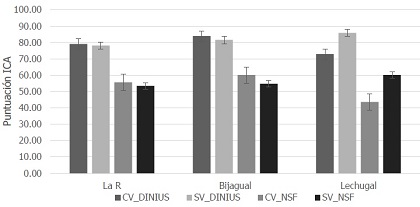Riparian vegetation and the quality of water resources in the central zone of the Ecuadorian coast
DOI:
https://doi.org/10.28940/terra.v40i0.1070Keywords:
pollution, physico-chemical and microbiological parameters, water resourcesAbstract
Riparian vegetation plays an important role in reducing the input of pollutants into water bodies. Water availability in Ecuador is plenty, however, rural areas are without access to quality water and agricultural expansion reduces riparian vegetation. The aim is to assess the quality of the water resource inf luenced by riparian vegetation in the rural area of the canton Mocache in Ecuador. The quantitative method was used. Eight physical, chemical and microbiological parameters were analysed at 12 sampling points with and without vegetation. Concentrations were compared with national (Tulsma) and international, World Health Organization, and United States Environmental Protection Agency (WHO and EPA) standards. We applied two water quality index (WQI), such as Dinius (1978) and NSF (1972). The results indicate a high concentration of total suspended solids in unvegetated areas (52.00 mg L-1) and the water does not meet the EPA standard for agricultural use. Faecal contamination is extremely high, the maximum concentration of faecal coliforms is 1 538.00 NMP.100ml-1in areas with vegetation and 23 493.33 NMP.100ml-1 for total coliforms in sites without f lora. The WQIs showed dif ferences in their quality assessment, Dinius characterized the water as regular to excellent while NSF as poor to regular. The water resources have faecal contamination and represent a risk for human consumption. Likewise, riparian vegetation does not inf luence water quality (P > 0.05).
Downloads
Publication Facts
Reviewer profiles N/A
Author statements
- Academic society
- Terra Latinoamericana
- Publisher
- Mexican Society of Soil Science, C.A.

















